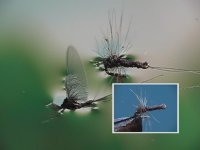Heritage-Angler
Active member
- Joined
- Sep 11, 2006
- Messages
- 3,307
All PAFF members, family, and friends are cordially invited to join us for the 2009 SE PA Trico Summit on the Little Lehigh.
This event will be held on Sunday, August 2 at 7AM.
Due to the nature of fishing the Trico spinner fall, and the desire of many members to have a "mini Jam" that they don't have to make a multi-day committment to, a central location in the state (ie. Spring Creek) was deemed impractical. Therefore, the event will be held on the banks of the Little Lehigh, providing good access to anglers from two of the three largest metropolitan areas in the state.
We'll meet in the parking lot off of Park Rd at 7AM, and there should be plenty of room for everyone to fish. The Tricos on the Little Lehigh have been providing outstanding fishing for a few weeks now, and there should be plenty of rising fish.
For those members that have never fished a Trico spinnerfall before - we'll try to pair you up with an experienced fisherman to help you out.
Waders are a good idea, but wet wading is an option (if you can stand the cold water). I'll have a case of spring water on ice in my truck, but it would be a good idea to carry some with you. Alcoholic beverages are not permitted in the Allentown Parkway system.
After the fishing and inevitable BS session, we'll be heading out to do lunch, and BS some more.
No sign up required - just show up by 7AM.
DIRECTIONS -just right click twice on the parking lot and choose your option.
H.A.
This event will be held on Sunday, August 2 at 7AM.
Due to the nature of fishing the Trico spinner fall, and the desire of many members to have a "mini Jam" that they don't have to make a multi-day committment to, a central location in the state (ie. Spring Creek) was deemed impractical. Therefore, the event will be held on the banks of the Little Lehigh, providing good access to anglers from two of the three largest metropolitan areas in the state.
We'll meet in the parking lot off of Park Rd at 7AM, and there should be plenty of room for everyone to fish. The Tricos on the Little Lehigh have been providing outstanding fishing for a few weeks now, and there should be plenty of rising fish.
For those members that have never fished a Trico spinnerfall before - we'll try to pair you up with an experienced fisherman to help you out.
Waders are a good idea, but wet wading is an option (if you can stand the cold water). I'll have a case of spring water on ice in my truck, but it would be a good idea to carry some with you. Alcoholic beverages are not permitted in the Allentown Parkway system.
After the fishing and inevitable BS session, we'll be heading out to do lunch, and BS some more.
No sign up required - just show up by 7AM.
DIRECTIONS -just right click twice on the parking lot and choose your option.
H.A.




